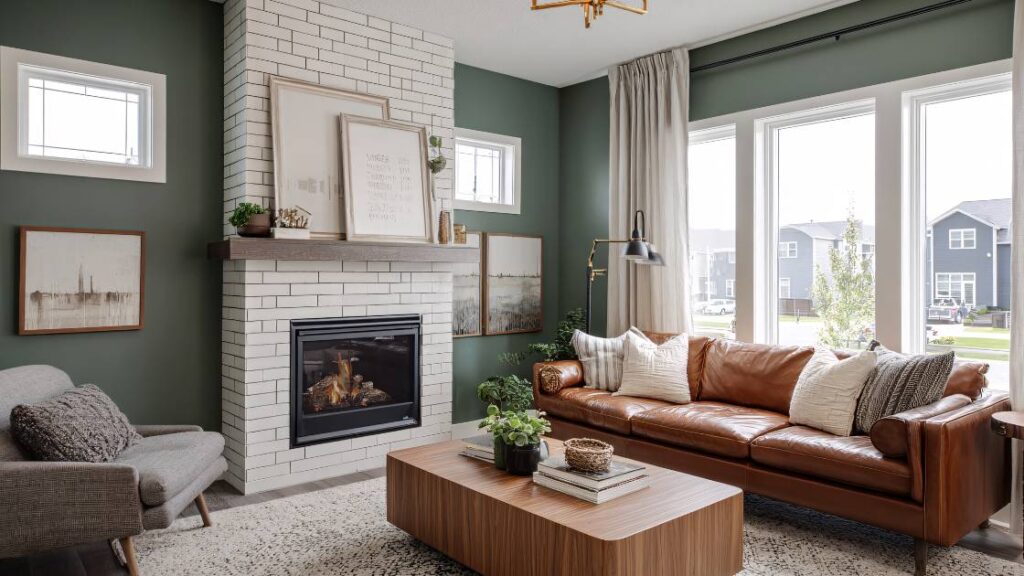Modern interior design is often praised for its simplicity, clean lines, and connection to the natural world. It’s a style that feels uncluttered, calming, and intentional.
But “modern” doesn’t mean cold or sterile. As a San Diego interior designer, I see it as a warm, inviting approach that creates sophisticated and livable spaces. It’s about stripping away the unnecessary to let high-quality materials and thoughtful forms shine.
If you find yourself drawn to organized, functional, and beautiful spaces, modern design might be the perfect fit for your home. A transformation doesn’t mean you have to start from scratch.
By incorporating a few key principles, you can introduce a modern aesthetic into any room and create a home that feels both current and timeless.
Let’s explore some practical tips to help you transform your space with a modern touch.
Embrace Clean Lines and Simple Forms
At the heart of modern design is a love for clean, straight lines. This principle applies to everything from the architecture of a room to the furniture within it. Think strong horizontal and vertical lines with minimal ornamentation. The goal is to create a sense of order and serenity.
You can start by evaluating your current furniture and decor. Look for pieces that have a simple, geometric silhouette. Sofas with low profiles, sleek armrests, and unadorned legs are a hallmark of modern design.
Coffee tables, consoles, and shelving should feature simple shapes without intricate carvings or embellishments. This focus on form allows the quality and material of the piece to become the main attraction. When you remove visual clutter, the entire space feels more open and breathable.
Adopt a Neutral Color Palette
Modern design often begins with a foundation of neutral colors. Shades of white, beige, gray, and black create a calm and unified backdrop that allows architectural details and statement pieces to stand out. A neutral palette helps make a space feel larger and brighter, a quality we cherish here in sunny San Diego.
However, neutral doesn’t mean boring. To add depth and interest, you can:
- Layer Tones: Mix different shades of the same neutral color. For example, pair a light gray wall with a charcoal sofa and a soft silver rug. This creates a sophisticated, monochromatic look.
- Introduce Natural Materials: Warm up a neutral space with the organic textures of wood, leather, stone, and metal. A warm oak floor or a rich leather accent chair can prevent the room from feeling cold.
- Use Color as an Accent: While the base is neutral, modern design welcomes bold, saturated colors in small, intentional doses. A single piece of vibrant artwork, a few colorful throw pillows, or a statement armchair can add personality and create a dynamic focal point.
Choose Minimalist and Functional Furniture
Modernism is rooted in the idea that form should follow function. This means that every piece of furniture in your home should have a purpose. Modern furniture is characterized by its minimalist aesthetic—it is unadorned, often raised off the floor on slender legs to create a sense of spaciousness, and crafted from natural materials.
When selecting furniture, prioritize quality over quantity. Instead of filling a room with many small items, choose a few high-quality, well-designed pieces.
A simple, elegant sofa, a sculptural coffee table, and a functional credenza can define a living room without overwhelming it. Look for materials like wood, metal, glass, and plastic used in innovative ways. The goal is an uncluttered environment where each piece serves a clear function while contributing to the overall aesthetic.
Let There Be Light: Modern Lighting Solutions
Lighting is a crucial element in modern interior design. The style favors open, light-filled spaces, so maximizing natural light is a top priority.
Keep window treatments simple and unobtrusive. Sheer curtains, simple roller blinds, or even bare windows (where privacy allows) can help connect your indoor space with the outdoors.
For artificial lighting, think of your fixtures as functional sculptures. Modern lighting design often features pieces with strong geometric shapes and metallic finishes.
- Statement Pendants: A large, sculptural pendant light over a dining table or kitchen island can act as a stunning focal point.
- Arc Floor Lamps: These iconic pieces provide both ambient and task lighting with a dramatic, sweeping form that adds visual interest.
- Track and Recessed Lighting: For a more minimalist approach, recessed lighting can wash walls with light and provide clean, overall illumination without cluttering the ceiling.
Layering your light sources—combining ambient, task, and accent lighting—will ensure your space is both functional and atmospheric, day or night.
Focus on Natural Materials and Texture
To prevent a modern space from feeling stark, it’s essential to incorporate a variety of textures and natural materials. This adds warmth, depth, and a tactile quality that makes a room feel inviting and complete.
Think about mixing different elements. Pair a smooth leather sofa with a chunky knit throw. Place a polished metal lamp on a rustic wood side table.
Lay a soft, high-pile rug on a sleek concrete or hardwood floor. Other materials to consider include linen, wool, stone, and natural fibers like jute or sisal. These organic elements provide a beautiful contrast to the clean lines and simple forms of modern furniture, creating a balanced and harmonious environment.
Bring Your Modern Vision to Life
Transforming your home with modern interior design is about creating a space that feels calm, organized, and effortlessly stylish. By focusing on clean lines, a neutral palette, functional furniture, and natural materials, you can craft a home that is both a peaceful retreat and a reflection of sophisticated taste.
If you’re inspired to embrace modern design but want a guiding hand, I’m here to help.



